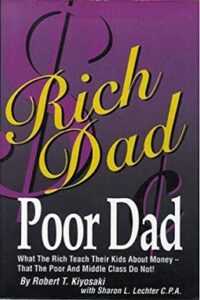“Rich Dad Poor Dad” is a life-changing book that teaches readers the fundamental principles of building wealth and achieving financial independence.
The book revolves around the story of the author, Robert Kiyosaki, who had two influential figures in his life, his own father (Poor Dad) and his best friend’s father (Rich Dad). Through their contrasting approaches to money, Robert learned crucial financial lessons that helped him become a successful investor, entrepreneur, and writer.
The book emphasizes the importance of financial literacy and the role it plays in building wealth. Robert argues that most people are stuck in the rat race, working hard to earn a living, but they never learn how to make their money work for them. He shows readers how to shift their mindset, challenge conventional wisdom, and take control of their finances by adopting the strategies and tactics of the rich.
In this summary, I will cover the 27 key takeaways from the book, with examples and quotes to help readers understand the concepts and apply them to their own lives. These takeaways cover a wide range of topics, including the difference between assets and liabilities, the power of passive income, the importance of financial education, the role of taxes in building wealth, and much more. By the end of this summary, readers will have a clear understanding of the principles of wealth-building and the mindset required to achieve financial independence.
Here are 27 key takeaways from the book with explanations, examples, and quotes:
- The rich don’t work for money, they make money work for them. Robert argues that most people work hard to earn a living, but the rich focus on making their money work for them. This means investing in assets that generate passive income, such as rental properties, stocks, or businesses. A person who buys a rental property and collects rent every month without doing any work is making their money work for them. “The poor and the middle class work for money. The rich have money work for them.”
- Assets put money in your pocket, while liabilities take money out of your pocket. Robert explains that assets are things that generate income or appreciate in value, while liabilities are things that require ongoing expenses or decrease in value over time. Example: An asset could be a rental property that generates rental income, while a liability could be a car that requires ongoing expenses such as fuel, maintenance, and insurance. “An asset is something that puts money in your pocket. A liability is something that takes money out of your pocket.”
- Your house is not an asset, it’s a liability. The author argues that many people view their homes as assets, but in reality, they are liabilities because they require ongoing expenses such as mortgage payments, property taxes, and maintenance. Example: A person who buys a house with a mortgage may think they have an asset, but in reality, they are responsible for ongoing expenses that take money out of their pocket. “Your house is not an asset, it’s a liability. It’s only an asset to the bank that holds the mortgage.”
- The difference between an employee, a self-employed person, a business owner, and an investor. Kiyosaki explains the four different types of people in the world of work and business and their different mindsets. An employee is someone who works for someone else, a self-employed person is someone who works for themselves, a business owner is someone who has a business that can run without them, and an investor is someone who makes money by investing in assets. “The rich focus on their asset columns while everyone else focuses on their income statements.”
- The power of passive income and how to create it. The author explains that passive income is income that is generated without active involvement and can be created through investments in assets such as rental properties, stocks, or businesses. A person who buys a rental property and collects rent every month without doing any work is generating passive income. “Passive income is the key to financial freedom and wealth.”
- The importance of financial education. The author stresses the importance of financial education and how it can help people understand how to make their money work for them. A person who learns about investing in stocks and bonds can make informed decisions about where to put their money to generate passive income. “The only difference between a rich person and a poor person is how they use their time and money.”
- The difference between good debt and bad debt. The author explains that not all debt is bad and that good debt is debt that is used to acquire assets that generate income or appreciate in value. A person who takes out a mortgage to buy a rental property is taking on good debt because the property generates rental income. “Debt can be a powerful tool if used properly and intelligently.”
- The power of leverage in investing. The author explains that leverage, or using other people’s money, can be a powerful tool in investing because it allows people to invest in assets they couldn’t afford on their own. Example: A person who takes out a loan to buy a rental property is using leverage to invest in an asset that generates passive income. “Leverage is the reason some people become rich and others do not.”
- The importance of taking calculated risks. The author emphasizes the importance of taking risks but also warns against reckless risk-taking. Example: A person who invests in a startup company after doing research and analysis is taking a calculated risk. “The biggest risk in life is not taking any risks.”
- The role of emotions in financial decision-making. The author explains how emotions can cloud judgment and lead to poor financial decisions. Example: A person who sells all their investments during a market downturn out of fear is making an emotional decision that may not be in their best interest in the long run. “The single most powerful asset we have is our mind. If trained well, it can create enormous wealth in what seems to be an instant.”
- The importance of networking and building relationships. The author stresses the importance of networking and building relationships with successful people who can provide guidance and mentorship. Example: A person who attends industry events and meets successful business owners can build relationships that may lead to valuable advice and opportunities. “The richest people in the world look for and build networks. Everyone else looks for work.”
- The importance of taking control of your financial future. The author emphasizes that people should take control of their financial future rather than relying on others to provide for them. Example: A person who starts a side hustle or invests in assets to generate passive income is taking control of their financial future. “The only way to achieve great wealth is to take calculated risks and be in control of your own destiny.”
- The importance of continuous learning and self-improvement. The author stresses that learning and self-improvement are key to success in any field, including finance and investing. Example: A person who reads books and takes courses on investing can continuously improve their knowledge and skills. “The more you learn, the more you earn.”
- The danger of relying on a single source of income. The author warns against relying on a single source of income, as it leaves people vulnerable to financial instability. Example: A person who loses their job and has no other sources of income may face financial hardship. “Never depend on a single source of income. Make investments to create a second source.”
- The importance of being financially literate. The author stresses that financial literacy is essential for making informed financial decisions and avoiding financial pitfalls. Example: A person who understands how to read a balance sheet can make informed decisions about investing in stocks. “The most important thing you can do to become financially free is to be financially literate.”
- The importance of saving and investing early. The author emphasizes that saving and investing early can have a significant impact on long-term wealth accumulation. Example: A person who starts saving and investing in their 20s can accumulate a much larger nest egg by retirement than someone who starts in their 40s. “The earlier you start investing, the better off you’ll be.”
- The importance of cash flow management. The author stresses the importance of managing cash flow to avoid overspending and to ensure that money is going towards investments that generate income. Example: A person who tracks their expenses and income can ensure that they are not overspending and that money is going towards assets that generate income. “It’s not how much money you make, but how much money you keep, how hard it works for you, and how many generations you keep it for.”
- The importance of taking action and not just talking about it. The author emphasizes that taking action is essential for achieving financial success, and that talking about it is not enough. Example: A person who takes action and starts investing in assets that generate passive income is more likely to achieve financial success than someone who only talks about it. “The size of your success is measured by the strength of your desire; the size of your dream; and how you handle disappointment along the way.”
- The importance of understanding taxes. The author stresses the importance of understanding how taxes work and how they can impact financial decisions. Example: A person who invests in tax-advantaged retirement accounts can save money on taxes and increase their long-term wealth. “The difference between rich people and poor people is that poor people pay a lot of attention to their income while rich people focus on their expenses.”
- The importance of taking calculated risks. The author emphasizes that taking calculated risks is necessary for achieving financial success, but that risks should be carefully evaluated to minimize potential losses. Example: A person who invests in a diversified portfolio of stocks and bonds is taking a calculated risk that has the potential for long-term growth. “The most successful people in life are the ones who ask questions. They’re always learning. They’re always growing. They’re always pushing.”
- The importance of being flexible and adaptable. The author stresses the importance of being flexible and adaptable in the face of changing economic conditions and opportunities. Example: A person who adjusts their investment strategy in response to changing market conditions is more likely to achieve financial success than someone who sticks to a rigid plan. “In today’s rapidly changing world, the people who are not taking risk are the risk takers.”
- The importance of taking responsibility for your financial situation. The author emphasizes that people should take responsibility for their financial situation rather than blaming others for their lack of success. Example: A person who takes responsibility for their financial situation and actively seeks out opportunities to improve it is more likely to achieve financial success than someone who blames external factors for their lack of progress. “If you’re not a part of the solution, then you’re part of the problem.”
- The importance of thinking long-term. The author stresses the importance of thinking long-term and making decisions that will benefit you in the future, rather than seeking short-term gains. Example: A person who invests in stocks with a long-term growth strategy is more likely to achieve financial success than someone who seeks short-term gains through day trading. “The future belongs to those who prepare for it today.”
- The importance of being proactive rather than reactive. The author emphasizes the importance of being proactive and taking action to create opportunities, rather than waiting for them to come to you. Example: A person who starts their own business to generate income and build wealth is being proactive, rather than waiting for a job opportunity to come along. “The biggest challenge you have is to challenge your own self-doubt and your laziness. It is your self-doubt and your laziness that defines and limit who you are.”
- The importance of being persistent and not giving up. The author stresses the importance of persistence in achieving financial success, and emphasizes that setbacks and failures are opportunities to learn and grow. Example: A person who experiences a setback in their business but continues to work towards their goals is more likely to achieve success than someone who gives up at the first sign of failure. “The size of your success is measured by the strength of your desire; the size of your dream; and how you handle disappointment along the way.”
- The importance of surrounding yourself with positive influences. The author emphasizes the importance of surrounding yourself with positive influences, including mentors and supportive friends and family members. Example: A person who joins a networking group for entrepreneurs and surrounds themselves with successful business owners is more likely to achieve financial success than someone who isolates themselves from positive influences. “You’re only as successful as the people you surround yourself with.”
- The importance of living below your means. The author stresses the importance of living below your means and avoiding overspending, as it can lead to financial instability and inhibit wealth accumulation. Example: A person who lives frugally and saves money on unnecessary expenses is more likely to build wealth over time. “It’s not how much money you make, but how much money you keep, how hard it works for you, and how many generations you keep it for.”
To summarize, “Rich Dad Poor Dad” by Robert Kiyosaki provides a unique perspective on personal finance and wealth creation, challenging readers to rethink their beliefs about money and offering practical advice for achieving financial success. Through his personal experiences and lessons learned from his “rich dad” and “poor dad,” Kiyosaki emphasizes the importance of financial education, investing in assets, and taking calculated risks to build long-term wealth.
The 27 key takeaways covered in this summary offer valuable insights into the mindset and strategies needed to achieve financial success, from developing a strong work ethic and cultivating a mindset of abundance to being proactive, persistent, and surrounding oneself with positive influences. Whether you’re just starting out on your financial journey or looking to take your wealth-building efforts to the next level, “Rich Dad Poor Dad” is a must-read for anyone looking to achieve financial freedom and success.
Finance Startups like to work from Work Theater, our coworking space in Bangalore.
Learn more about our coworking space on Think Remote.




